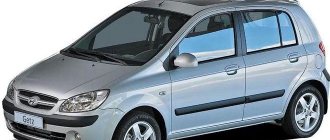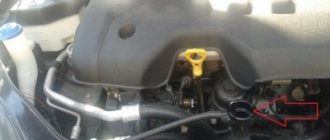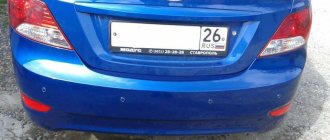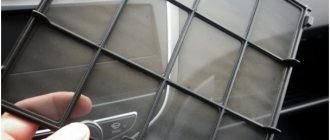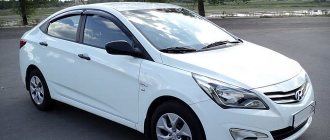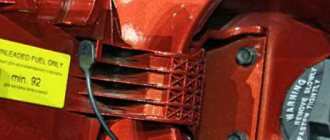Replacing any operating fluid is a standard procedure. Car owners need to regularly monitor the condition of the lubricants in the vehicle, check the oil and transmission mixture. The list of compounds used is not limited to this. You definitely need to worry about replacing the coolant - antifreeze.
I have a fashionable but budget car - a Hyundai Solaris 1.6 liter. The car is comfortable, but does not have a very powerful engine. However, you still need to use a cooler. In the article I will talk about what kind of antifreeze to fill in the Hyundai Solaris, and how to choose the right product?
What kind of antifreeze is poured into Solaris from the factory?
The car's instructions do not contain any specific explanations as to which antifreeze is best to pour into Solaris. There is a lot of information about the volume of the system and the principle of operation of the cooler. One important point is indicated - you need to fill the car with a mixture of ethylene glycol concentrated coolants and distillate.
Proportion 1:1. This option is provided in the vast majority of cases. However, for cars of different years of production, a completely different cooler is used:
- Hyundai Long Life Coolant (specification MS-591-08) – poured into cars assembled in Korea;
- antifreezes produced in Russia. They are characterized by low cost.
Original Hyundai antifreeze is very expensive, so vehicle owners rarely buy it. Some users note that the product is of lower quality than domestic antifreezes. Car manufacturers do not recommend filling in a product that has low technical characteristics. This is according to
When to change
Replacing Hyundai Solaris antifreeze according to the operating manual is carried out over time or after a certain mileage. Otherwise, unwanted deposits may appear in the engine block, and if the manufacturer's recommendations are constantly ignored, the engine may boil.
When to change the coolant on Solaris? The manufacturer recommends the first replacement of technical fluid at a mileage of 200,000 kilometers or upon reaching 10 years of operation. In the future - after 2 years or 30,000 kilometers.
In addition to meeting the deadlines, you must strictly adhere to the recommended brand of coolant. The type is not determined by color. But it is only a determining factor in packaging for the manufacturer. When choosing, you need to pay attention only to the brand.
In the manufacture of technical fluids, various bases and many additives are used. The latest generation has an index of G12++ and G13 - they are made from organic components with the addition of mineral inhibitors. They are called Lobrid coolants or Soat coolants.
What properties should coolers have?
All types of antifreeze can be divided into several groups. Distribution occurs based on what properties a particular composition has:
- does not freeze in the cold and does not cause corrosion in the engine;
- lubricates the pump;
- does not boil at a temperature of 130-140 degrees Celsius;
- Using this product you can flush the cooling system;
- does not allow foam to form.
All these properties become available through the use of unique additive complexes. There are several antifreezes that are not recommended to be poured into the engine, as they can cause serious harm to the car. Particularly harmful compounds in this regard are colored blue. I don’t recommend pouring Soviet antifreeze into Solaris, since the car’s components will come to an end very quickly. Among modern ones, you should not fill in a nitrite composition marked TL.
Refrigerant quality check
When buying antifreeze, especially from a well-known brand, you are not immune from purchasing a low-grade counterfeit. Checking the quality of the purchased liquid is very simple - just determine its boiling point. For a good antifreeze it will not be lower than +107 °C at atmospheric pressure.
You can measure the indicators using a multimeter or infrared thermometer. When using the latter, keep in mind that the thermometer can give an error in the range from 3 to 7 degrees.
In addition to determining the boiling point, you can evaluate the color of the coolant after a certain period of its operation. Counterfeit goods very quickly lose their original color and become colorless or brown.
Is it allowed to mix antifreeze of different brands?
You should not combine products from different brands, although there are exceptions. To top up in small quantities, you should use distilled or ordinary water. In the future, it is better to completely replace all antifreeze than to mix it with another liquid. Before filling in a new cooler, it is recommended to flush the system with distillate.
The first signal indicating that a fluid change is required is a loss of color. The second point is the operating conditions. The higher the temperature, the more liquid will evaporate. This means that for cars operating in difficult conditions, antifreeze needs to be changed more often. Each car has its own rules for replacement; here it is important to act strictly according to the instructions.
How do you know if the fluid needs to be replaced or not?
If you bought a used car, you shouldn't look at the mileage. In Solaris it is very easy to twist. You can find out that it is twisted only by indirect signs. Mileage data is stored in only one chip, into which the new mileage is recorded. The second reason why you should not rely on odometer readings is the possible replacement of the radiator. If the radiator was changed (let's say the car got into an accident or a dog was hit, which happens quite often), then we can assume that the cheapest antifreeze was poured in. For some reason, many people think that they can fill in any color as long as they want it. As a rule, they take the cheapest one.
Recommendation: If the antifreeze does not have a clear factory color, REPLACE IT WITH A NEW one - one that you will be absolutely sure of! If you have a car with a transparent history, use the recommendations above.
Replacing antifreeze in Hyundai Solaris - step-by-step instructions
Immediately before starting to change the fluid, it is worth studying the layout of the corresponding tank. The decision to replace should be made after the coolant level has been determined to be low.
When the consumption is more than a liter per 10 thousand km, this indicates a malfunction in the system, which means it’s time to start replacing the product. You need to do this:
- Remove the reservoir cap and radiator cap. Remove the shield that protects the power unit from dirt.
- Carefully unscrew the drain valve, but not all the way. This will reduce the degree of pressure and the volume of the drained mixture. Place a container under the old antifreeze.
- When draining antifreeze, you need to check the condition of the sealing ring. If it is cracked, it needs to be replaced.
- Remove the remaining coolant using a special syringe or syringe bulb.
- Close the tap and fill the coolant tank to the level marked “L”. Close the traffic jam and start the car.
After the replacement is completed, an air lock may appear in the car, but within an hour or two it will go away on its own.
Let's sum it up
Taking into account the above information, it becomes clear that only the latest generations of antifreeze are suitable for Hyundai Solaris. At the same time, you should not fill in both the cheapest G11 and the expensive G13. It is optimal to opt for G12, G12+ or G12++. The only thing is that it is also advisable to separately take into account the individual features and properties of these liquids in order to select the most suitable option.
We also recommend reading the article about which antifreeze to choose, G11 or G12. From this article you will learn what the differences are between these classes of antifreeze, as well as which fluid is best to choose for the cooling system of different cars and why.
Finally, we note that provided that Hyundai Solaris antifreeze is correctly selected and regularly replaced, the cooling system of this car is highly efficient and stable. In turn, this is reliable protection of the power plant from general or local overheating, which significantly increases the life of the internal combustion engine.
The most popular engine for Hyundai Solaris
Gamma engines divide this line almost in half, but still, the G4FC engine “withstood” a little more configurations. They are very similar to each other. The FC engine was “increased” in displacement from 1396 to 1591 cubic centimeters, increasing the free stroke of the piston. The year of birth of the unit is 2007. The assembly place is the Hyundai automobile plant in the capital of China, Beijing.
Inline four-cylinder fuel-injected engine producing 123 hp. designed to meet Euro 4 and 5 environmental standards. Fuel consumption (for the option with a manual transmission):
- in the city - 8.0 l.;
- outside the city - 5.4 liters;
- combined - 6.4 l.
The motor has a number of design features characteristic of modern Korean engines:
- distributed injection of the MPI type (multipoint multi point injection);
- the cylinder block and head are made of light and durable aluminum alloy;
- plastic intake manifold;
- two camshafts (DOHC);
- chain drive with tensioner in the timing mechanism.
Of particular interest is the multipoint distributed injection system installed in the engine. It has five main structural elements:
- Throttle valve.
- Ramp (main) for fuel distribution.
- Injectors (nozzles).
- Air consumption (or pressure/temperature) sensor.
- Fuel regulator.
The operating principle of the system is quite simple. The air passes through the atmospheric filter, mass flow sensor and throttle valve into the intake manifold and engine cylinder passages. Fuel comes to the injectors through a ramp. The proximity of the intake manifold and injectors minimizes gasoline losses.
More on the topic: Hyundai Solaris tires: standard and permissible tire sizes, pressure
Control is carried out using the computer. The computer calculates the mass fractions and quality of the fuel mixture based on load, temperature, engine operating conditions and vehicle speed. The result is electromagnetic pulses for opening and closing the injectors, supplied at a certain moment from the control unit.
MPI injection can operate in three modes:
- simultaneously;
- in pairs;
- individually.
The advantages of this fuel injection scheme include efficiency and full compliance with environmental standards. But those who prefer to buy a car with an MPI engine should forget about dashing high-speed driving. Such engines are much more modest in terms of power than those in which the operation of the fuel system is organized according to the principle of direct supply.
For the G4FC, Hyundai has set a fairly low mileage threshold - 180 thousand km (10 years of operational use). In real conditions, this figure is much higher. Various sources provide information that Hyundai Solaris taxis cover up to 700 thousand km. mileage A relative disadvantage of this engine is the lack of hydraulic compensators as part of the timing mechanism, and the need to adjust the valve clearances.
Overall, the G4FC proved to be an excellent motor: light in weight, inexpensive to maintain and unpretentious. However, it is worth considering that from the point of view of major repairs, this is a one-time item. All that can be done on it is plasma spraying of cylinders and boring to the nominal size. However, is it necessary to think about what to do with an engine that can easily “travel” half a million kilometers is a rhetorical question.
More about Solaris
- General information about the Hyundai Solaris
- Solaris engine overhaul
- Weaknesses of Solaris. Main problems of Hyundai Solaris: Infographics.
- Hyundai Solaris Body Dimensions - Dimensions Tables
- How serious are the problems of the Hyundai Solaris?
- Tuning Hyundai Solaris with your own hands: interior, optics, chip tuning
- Hyundai Solaris 2022: Comfort package
- Hyundai Solaris 2022 - photos and prices, videos, characteristics of the new Hyundai Solaris 2
- We bring the updated Hyundai Solaris into the lair of competitors. Test drive hyundai solaris - DRIVE
- Hyundai Solaris 1.4, 1.6 fuel consumption per 100 km
Level control and required volume
The maximum capacity of the Solaris engine cooling system is 5.3 liters.
To control the liquid level in the system, a translucent expansion tank is used. It is installed directly on the radiator of the cooling system on the right side. On the front surface of the tank there are two notches with the designations L (low - low) and F (full - full). The volume of liquid in normal condition should be near the upper mark. The system will fully cool the engine only at this level. When the amount of liquid drops below the middle, especially below the L mark, refrigerant is added. Only add antifreeze of the brand that is in the system. Topping up is carried out through a special sliding funnel pipe located in the neck of the tank.
The tank is circled in red; liquid level marks are visible on the wall.
Possible causes of coolant consumption
During vehicle operation, the fluid level may decrease slightly. This is due to the fact that the expansion tank of the Hyundai cooling system is not completely sealed and antifreeze can evaporate from it. Significant loss of refrigerant within a short time indicates possible damage to the pipes or radiator. In this case, it is necessary to check the system and repair the damaged areas.
In this case, you should check that there is no antifreeze in the engine lubrication system. This happens when the sealing gasket between the head and the cylinder block is destroyed. If there is liquid in the oil, its level in the crankcase will increase significantly and traces of the emulsion will be visible on the dipstick.
Where to see the fluid level and color
If the car is cold and you just want to see the color of the fluid, it is more convenient to do it here.
On a warm car, the fluid level can be viewed here.
Over time, the tank becomes cloudy, and it becomes difficult to see the level and, even more so, understand the color of antifreeze. In this case, even with a warm car, you can remove the cap from the reservoir and determine the fluid level using the hose. If you look into the tank, you can see the color.
Signs of deteriorating coolant condition
For full functioning of the Hyundai Solaris, antifreeze is of great importance, so it is important to know and notice in time the signs of deterioration of the solution.
For example, a sharp deterioration in the condition of a substance is indicated by the presence of chips, scale or sediment in it. It is very easy to understand that the coolant is losing its properties by changing color, mainly they begin to acquire a reddish tint. When thinking about whether it is necessary to update the contents of the tank and when hesitating which antifreeze to fill, you can check with a refractorometer and a hydrometer. The results of the test strip will tell you when it is time to fill in a fresh solution and which one to choose so as not to harm your car.
Proper care of the Hyundai Solaris will not only extend the period of useful service, but will also guarantee the driver’s safety behind the wheel. It is necessary to maintain the coolant in good condition, because engine performance depends on its quality.
What to choose?
Where the antifreeze is located, it’s clear what it does too. But which one should you choose for the Hyundai Solaris? In order not to follow the manufacturer’s lead, you need to independently understand all the nuances of such liquids. Otherwise, you can waste your money on a fairly expensive product. So, for example, 10 liters of not the best antifreeze costs about 500 rubles.
Any coolant has its own class, there are 3 of them. It’s worth noting right away that you need to pay attention to them. The best class of them will be useful not only for the Hyundai Solaris, but also for any other car.
1st class – G11. The lowest class indicates the worst coolants, for example, those that contain few different additives. However, these additives may have anti-corrosion and lubricating properties.
The next class is G12. This coolant is already much better than its predecessor, since it contains ethylene glycol and carboxylate compounds. Such antifreeze can form an anti-corrosion film only in places where hot spots are located, so heat removal does not lose its effectiveness.
Class G13. In terms of its properties, objectively, it is the best class of antifreeze of all those currently on the market. It contains polypropylene glycol, which makes it environmentally friendly and non-toxic. That's all. The obsession with safety, of course, is associated with high European standards, which are now sweeping Russia.
Cooling system
To better understand which fluid is suitable for Hyundai Solaris, you need to understand what it consists of. Or rather, the part where antifreeze will be poured. But you need to start not so much with the system itself, but with its main component - the coolant. It consists of ethylene glycol, as well as special additives. The least important components include dyes and water.
Thanks to this composition, this liquid never freezes, even during extremely cold weather. The freezing point of antifreeze is much lower when compared to water. That is why it is strictly forbidden to pour water into the Hyundai Solaris, or into any other car. Coolant circulates through the engine jacket, so freezing can lead to dire consequences.
Adviсe
The nominal volume of the internal channels of the cooling system is 5.3 liters. Since the drain is made only from the radiator part and the expansion tank, coolant remains in the engine and heater core. Therefore, the amount of liquid is about 4 liters.
When changing the composition, an air lock may be created. If it has formed, and on a warm engine this will be indicated by cold air flowing from the interior heating system, then you should stop the internal combustion engine and allow it to cool. Afterwards, remove the cap from the radiator and start the engine for a few minutes - the air will come out.
A little about concentrated formulations
The basic recommendation for preparing ready-made antifreeze from concentrates is the same: 50% emulsion to 50% distilled water. This is, in general. If you carefully read the manual, you can see the profile plate. It provides the relationship between the minimum operating temperature of antifreeze, the concentrations of commercial emulsion and deionized water:
| Freezing temperature, °C | Concentrated antifreeze, % | Water, % |
| -15 | 35 | 65 |
| -25 | 40 | 60 |
| -35 | 50 | 50 |
| -45 | 60 | 40 |
- Note for those purchasing a pre-made unlicensed product. The manufacturer warns that you should not buy solutions with a mass fraction of antifreeze content of less than 35% and more than 60%. They are ineffective.
Leaks and problems
Hyundai Solaris does not have any particular problems with the cooling system. Unless the filler cap should be changed periodically. Since sometimes the bypass valve located in it fails. This creates increased pressure, which sometimes leads to leaks at the joints.
Sometimes users may complain about increased engine temperature; this can be treated, as it turns out, by externally flushing the radiator. Over time, dirt gets into the small cells, which disrupts normal heat exchange. As a rule, this happens on older cars that have had time to travel in various conditions.

